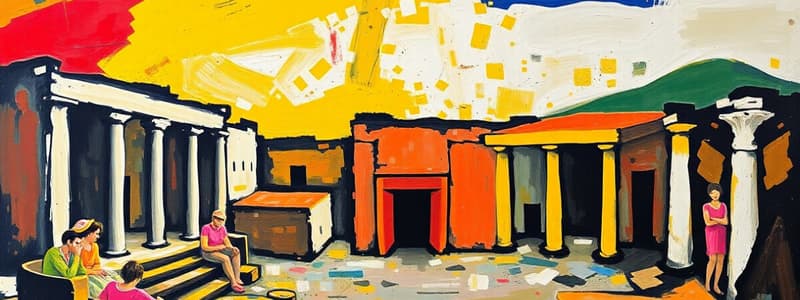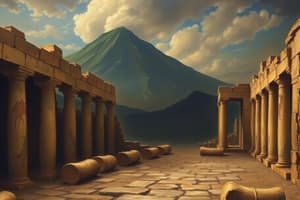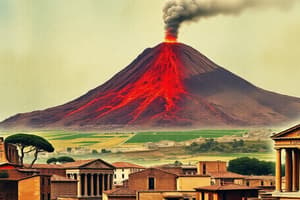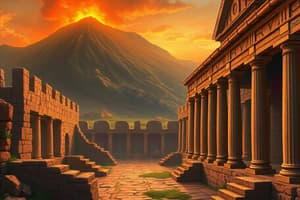Podcast
Questions and Answers
What led to the burial of Pompeii and surrounding areas in AD 79?
What led to the burial of Pompeii and surrounding areas in AD 79?
- Mount Vesuvius erupted. (correct)
- A tsunami hit the region.
- A volcanic winter occurred.
- An earthquake caused landslides.
What geographical feature is Herculaneum located near?
What geographical feature is Herculaneum located near?
- An elevation of mountains.
- A river delta.
- A desert region.
- The west coast of central Italy. (correct)
What significant change was made to the beach for accessibility purposes?
What significant change was made to the beach for accessibility purposes?
- The beach was covered with concrete.
- The original sand was left untouched.
- Dark-colored material replaced the original black sand. (correct)
- The beach was removed entirely.
What were some of the other attractions found in Herculaneum besides the beach?
What were some of the other attractions found in Herculaneum besides the beach?
In what year was the beach in Herculaneum opened to the public after restoration?
In what year was the beach in Herculaneum opened to the public after restoration?
What discovery in the 1980s, 1990s, and 2000s contradicted earlier beliefs about Herculaneum's residents?
What discovery in the 1980s, 1990s, and 2000s contradicted earlier beliefs about Herculaneum's residents?
Why was Herculaneum once a popular destination for Rome's upper-class families?
Why was Herculaneum once a popular destination for Rome's upper-class families?
During which period were Herculaneum's important artifacts and buildings revealed through excavation?
During which period were Herculaneum's important artifacts and buildings revealed through excavation?
Flashcards
Mount Vesuvius Eruption
Mount Vesuvius Eruption
A volcanic eruption in AD 79 that buried Pompeii and surrounding areas, including Herculaneum, under thick volcanic ash.
Herculaneum
Herculaneum
An ancient Roman seaside resort on the west coast of Italy, buried by the eruption of Mount Vesuvius.
Herculaneum Archaeological Park
Herculaneum Archaeological Park
The preserved remains of the ancient Roman city of Herculaneum, showcasing the city's beach, baths, theater, and homes.
Volcanic Ash
Volcanic Ash
Signup and view all the flashcards
Skeletons of Herculaneum
Skeletons of Herculaneum
Signup and view all the flashcards
Discovery of Herculaneum
Discovery of Herculaneum
Signup and view all the flashcards
Herculaneum Beach Restoration
Herculaneum Beach Restoration
Signup and view all the flashcards
Dark-colored material
Dark-colored material
Signup and view all the flashcards
Study Notes
Mount Vesuvius Eruption and Herculaneum Excavation
- Herculaneum, a Roman seaside resort, was buried by Mount Vesuvius's AD 79 eruption.
- The city's beach has been excavated and reopened to the public in June 2024.
- The beach's restoration allows visitors to experience the site as ancient Romans did.
- The original black sand beach was replaced with a dark-colored material for wheelchair accessibility.
- The site reveals other well-preserved attractions, including baths, an underground theater, and lavish homes.
Herculaneum's History and Significance
- Herculaneum, named after the Greek god Hercules, was a popular vacation spot for wealthy Romans.
- The city remained hidden under over 150 feet of ash until its accidental discovery in 1709.
- Excavations in the 18th and 19th centuries uncovered buildings, art, scrolls, and artifacts, but few human remains initially.
- Later excavations (1980s-2000s) revealed over 300 skeletons.
- Skeletons of women, children, and babies were found sheltered in boat houses; men were found on the beach.
- This suggests people fled to the beach seeking rescue by boats.
- The "Ring Lady" skeleton, adorned with jewels, and a Roman soldier's remains (with belt and weapons) were prominent discoveries.
Ongoing Excavations and Findings
- Ongoing excavations at Herculaneum, Pompeii, and surrounding areas continue to unveil new insights.
- New discoveries include a shrine with blue walls and a vibrant war-themed banquet room.
- The unearthed human remains provide valuable insights into the lives and deaths of the inhabitants.
Studying That Suits You
Use AI to generate personalized quizzes and flashcards to suit your learning preferences.
Description
Explore the fascinating history of Herculaneum, a Roman resort buried by the Mount Vesuvius eruption in AD 79. Discover the significance of recent excavations, the restoration of its beach, and the ancient attractions uncovered over centuries. Delve into the stories of its past inhabitants and the remarkable artifacts discovered in this archaeological site.





